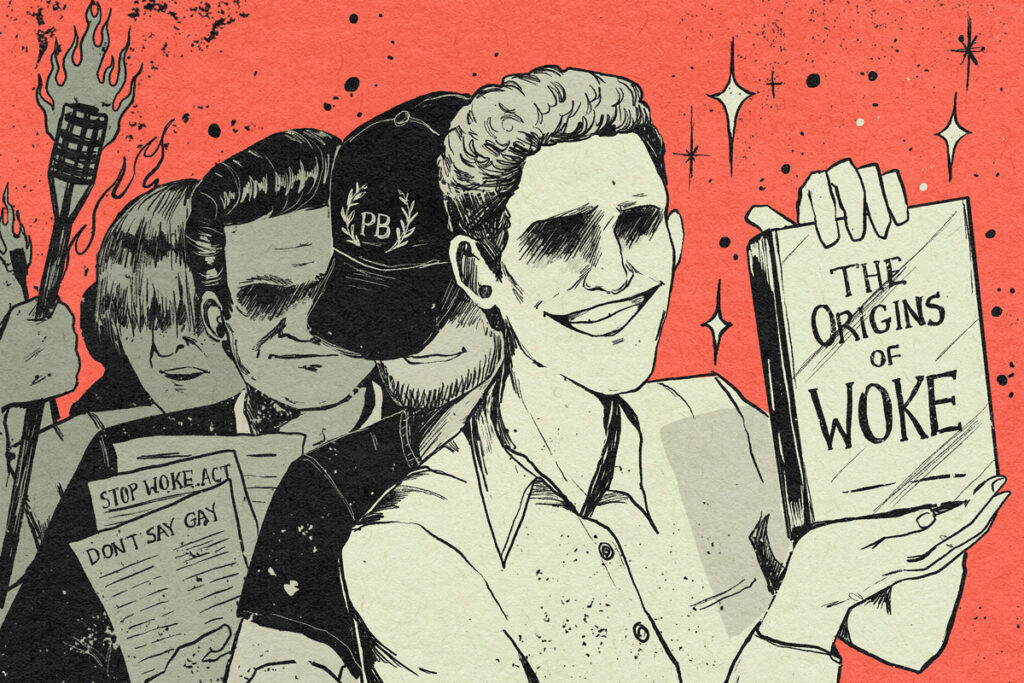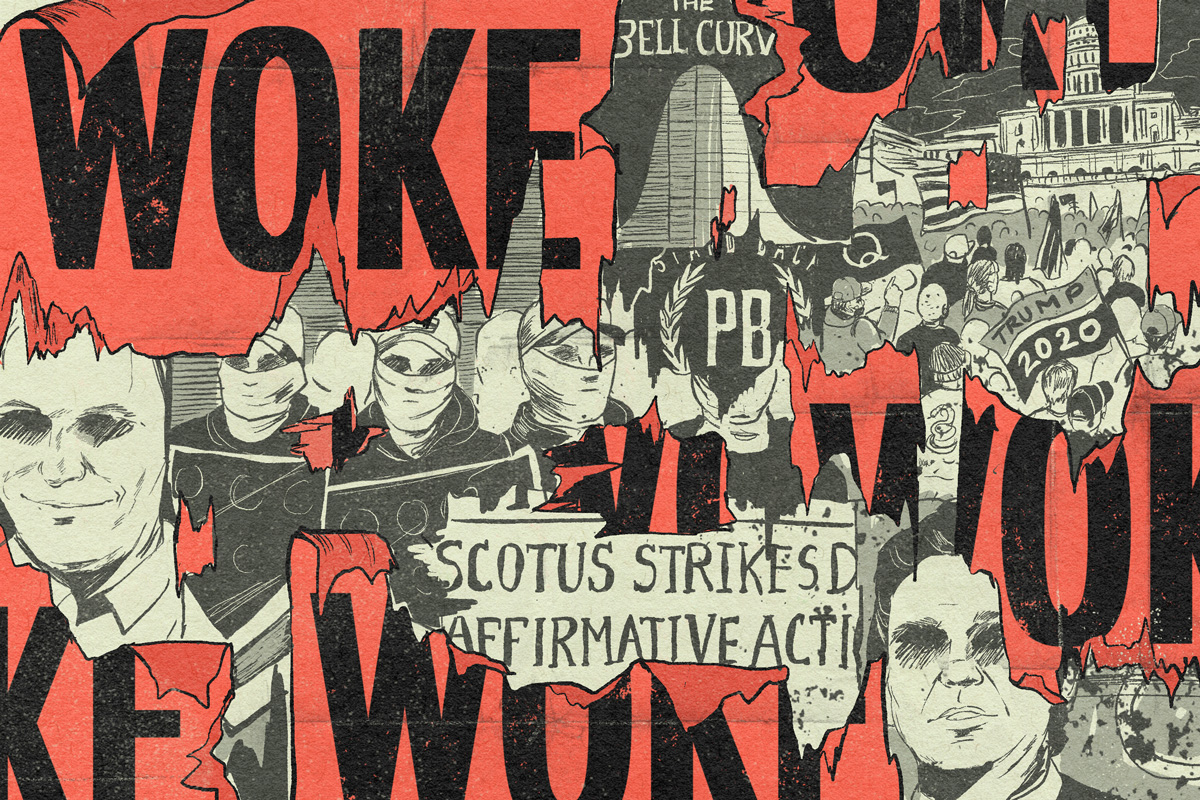In June of 2009, “Richard Hoste,” a writer and contributor to a plethora of white nationalist websites, lambasted conservatives’ perceived weakness in the face of a growing antiracist movement.
“How many conservatives would be willing to say that there is something wrong with black people and the Mexicans who will be our rulers by the end of the century? If you don’t, don’t be surprised if people find anti-racism the only thing that explains what they see right in front of their eyes,” “Hoste” bemoaned.
“Hoste,” a 2023 Huffpost investigation revealed, was once the preferred nom de guerre of the up-and-coming conservative intellectual Richard Hanania, who is now thirty-eight years old. As “Hoste,” Hanania lamented the mainstream right’s lack of appetite for “human biodiversity,” a prettier term for scientific racism; encouraged society to “[give] up the crusade for equality of outcome”; expressed exasperation with “anti-white cultural trends” and said “[t]he most prestigious institutions in society have heaped so much mock and scorn on traditionalist whites that people of other races have gotten the hint”; and urged white nationalists to claim their place within the “mainstream Right.” For “Hoste,” a just world would come after the political elite embraced eugenics, tossed aside concerns regarding equity in education, and organized society on the basis of IQ.
This “alternative right,” as “Hoste” later described it in one of Richard Spencer’s now-defunct webzines, aimed to upend “the entire idea-making establishment” through the formation of “a political and social culture that is a better fit with human nature than the one we currently have.” This new movement would blend critiques of Bush-era neoconservatism with a racist pseudoscience that it claimed would define the differences in the “inherent capabilities” of different races and sexes.
“People to a large extent act as if they agree with us. And they’ll be healthier socially and as individuals when they’ll be able to say so openly,” “Hoste” wrote in a Feb. 24, 2010 post on “Alternative Right.”
Hanania has sought to distance himself from his writings as “Hoste” in the wake of Huffpost’s investigation, writing in an essay on Substack that, “I truly sucked back then.” While Hanania’s attempt to portray himself as reformed has not kept him from opining on race and crime statistics and stating that “the Voting Rights Act writes Black Nationalism into law,” his lengthy appeal to readers to consider his intellectual evolution does hold a kernel of truth. His recent book, The Origins of Woke, eschews many of the improprieties of the white nationalist blogosphere—such as overt racist language—in favor of legalese in the service of a reactionary hierarchy. It is a 288-page instruction manual for upending decades of civil rights legislation that American lawmakers passed in order to better the lives of racial, religious, and sexual minorities—all recast as a struggle against the amorphous enemy “wokeness.” Hanania’s fever-dream of annihilating the “post-1964 regime,” referring to the 1964 Civil Rights Act that outlawed discrimination on the basis of race, religion, sex, and national origin, represents a bleak vision for the world—one that’s meant to turn the clock back on decades of struggling for racial justice—and uses pseudoscientific invectives to bolster his claims. The fact that it has found favor among both the far-right fringe and some of the world’s richest and most powerful men speaks volumes about the state of the American right.
The idea that “wokeness” is the animating force behind modern American institutions seems perplexing given that a Republican president with a proclivity for hiring white nationalists encouraged an armed coup against the U.S. government just three years ago. Though the term “woke” has a long history in Black racial justice circles, the right’s obsession with it began in 2020. Since then, conservatives’ use of the term has spun out to refer to a litany of grievances with the left.
Today, the words “woke” and “wokeness” in conservative cultural and political commentary represent a form of rot threatening the integrity of American institutions. “Anti-woke” rhetoric is now de rigueur for any Republican with national ambitions. Alabama senator Tommy Tuberville blamed teachers’ unions for spreading a “woke socialism agenda” during this year’s Conservative Political Action Conference outside of Washington, D.C. Presidential primary candidate Nikki Haley said during the same event a year prior that “wokeness” is “a virus more dangerous than any pandemic, hands down.” Former presidential primary candidate and Florida governor Ron DeSantis—who promised to turn the state into a place where “woke goes to die” after his reelection in 2022—continues to champion policies protecting children against “woke indoctrination.”
Yet, for all the monstrous danger that “wokeness” supposedly poses to the American body politic, finding a systematic definition of “wokeness” has long proved elusive. Even Chris Rufo, the ideological architect of the right’s closely aligned panic over “critical race theory” whom DeSantis conscripted to run the formerly left-leaning, publicly funded New College in Florida last year, told The New Yorker in 2021 that, “‘woke’ is a good epithet, but it’s too broad, too terminal, too easily brushed aside.” In The Origins of Woke, Hanania aims to change that.
For Hanania, “wokeness” rests on three pillars. The first is the belief that “disparities equal discrimination”—meaning, any differences in pay or representation among people who are not white and/or not male is the result of systemic injustice. The second is that “woke” institutions rely on direct or indirect restrictions on speech, such as retaliatory firings or other forms of discipline, to silence those who disagree with their radical left-wing consensus, especially on issues like differences between races. The third is that “woke” institutions have imposed and maintained their hegemony through the formation of a “human resources bureaucracy.” These first two “pillars,” Hanania continues, define whether someone or something can be considered “woke,” while the third examples how “wokeness” can be expressed on an institutional level.
The Origins of Woke emphasizes a handful of cases and pieces of legislation that have supposedly created the conditions for “wokeness” to thrive. He dedicates an entire section to Title IX, which restricted sex-based discrimination in schools and educational programs that received federal funding. According to Hanania, Title IX has become “a method of social engineering” and a means of implementing legislation that flattens what he perceives as natural gender differences, such as men’s athleticism. Hanania also details how several prominent employment law cases lay the groundwork for “wokeness.” This includes less-discussed Supreme Court opinions like Griggs v. Duke Power Co., a 1971 case that established precedent for lawsuits on the basis of “disparate impact.” (In legal parlance, “disparate impact” refers to a situation in which certain criteria, such as requirements in the hiring process, can disproportionately target minorities despite appearing neutral.)
Undoing decades of civil rights legislation is not an easy lift, Hanania admits. “There will be no V-Day in the war on wokeness,” he writes. The battle for the hearts and minds of Millennials and Generation Z may be hopeless, Hanania laments, as they have benefitted from the current system for too long. Instead, Hanania argues that ending “wokeness” would require a fundamental reorganization of society around the principles of “merit and free speech” rather than those meaningless metrics of “equality.”
Baked into Hanania’s taxonomy of “wokeness” is the assumption that it poses a threat to American society. But The Origins of Woke conveniently fails to answer the question, cui malo? Those who want to ask for IQ scores in the hiring process? People who inexplicably lament that “the workplace has been ‘sanitized’ of all sexual content”? (Read: bosses who want to fuck their subordinates.)
And who could forget the archetypal victims of far-right extremists throughout the United States—the most beleaguered, embattled people of all: whites and men. “Intentional discrimination against white[s] and males is accepted, if not mandatory,” Hanania writes.
He never bothers to corroborate that claim throughout the book. He does not need to. The right has leaned so far into embracing white grievance that these statements can be taken as a given.
In the years since Donald Trump’s election in 2016—and particularly since the attack on the U.S. Capitol in January 2021—the modern American conservative movement has increasingly whittled its self-identity down to one precept: inexorable conflict with the left. Loosely defined (and intentionally so), the left is an archetypal “enemy.” Not merely an intellectual adversary, but a combatant in the sense that German legal theorist and early World War II-era Nazi Party supporter Carl Schmitt defined it: someone, or something, to whom “belongs the ever-present possibility of combat.”
“Wokeness” and related bogeymen, whether they be “critical race theory” or “cultural Marxism,” fuel this vision of the left as an existential threat. For right-wing “culture warriors,” those terms aren’t labels for fixed concepts so much as thought-terminating cliches that can be used to explain away almost any problem within the modern American workforce, or politics, for that matter. For instance, if a white guy with high test scores isn’t accepted into Harvard, it’s much more convenient to blame “woke” conformity than, say, any tangible personal or professional shortcomings in their application.

Like the narratives pushed by Rufo and others, Hanania’s intellectual history of the impact of civil rights legislation is a foil for his primary goal in writing the book—destroying “wokeness.” “My motivation stems from my opposition to wokeness and my belief that there is a political path forward for those who would like to do something about it,” Hanania writes. While Hanania pays lip service to some self-described liberal critics of antiracist politics, he admits in multiple places throughout the book that conservatives and Republicans are his primary audience.
In a chapter on “Republicans and Civil Rights Law,” Hanania invites Republicans to see “wokeness” as an enemy, writing,
Conservatives have united around the idea that something has gone terribly wrong, and the emotional reaction that is the backlash to wokeness has helped solidify a sense of tribalism and an accompanying hatred of an enemy that are conductive to taking political action.
In the same breath, Hanania praises the Republican Party’s hard-right turn, adding that previous concerns about whether certain policy proposals—such as abolishing affirmative action—could be characterized as “racist” bothers the current crop of GOP lawmakers less than in years past.
“To be ‘racist’ and ‘sexist’ can even be an advantage, depending on how tied to institutions you are,” Hanania wrote in a subscribers-only post on his Substack on Sept. 23, 2023, shortly after the book’s release. He cited Costin Alamariu, a Romanian-American man who writes self-styled far-right Nietzschean gobbledygook under the pseudonym “Bronze Age Pervert.” His radicalism, Hanania says, “is actually an advantage in appealing to young conservatives.”
This fluidity also makes it possible for Hanania and other critics of these various bogeymen to appeal to different audiences throughout the right—from white nationalists to more superficially respectable Republicans—while retaining some level of plausible deniability against accusations of racist dogwhistling.
Emphasis on some. Hanania does cite white nationalists and figures adjacent to the movement. To support his argument about the costliness and ineffectiveness of workplace diversity, Hanania references a 1990 article that Peter Brimelow, founder of the white nationalist website VDARE, co-authored during past career at Forbes. The article discusses the cost of such quotas in the federal workforce. VDARE reprinted the article in full on their website; Hanania cites the original Forbes article in print.
In another section, Hanania refers to long-time VDARE contributor and race science proponent Steve Sailer with the vague title “writer.” In a footnote, Hanania cites multiple articles he wrote for his personal website, iSteve, in 2012 and 2014. In the same section, Hanania includes a link to Sailer’s work at The Unz Review, a far-right website that regularly publishes the work of neo-Nazis, white nationalists, and other extremists.
In the fall of 1994, Sam Dickson, a former lawyer for the Ku Klux Klan, gathered several dozen movement stalwarts at a lodge in Urbana, Illinois, for a memorial in honor of Revilo P. Oliver, a mentor to a range of infamous white supremacist leaders. Among the event’s speakers was David Duke, the former Klan leader turned presidential candidate, who expressed a sense of optimism about his movement’s future. “‘Heredity’ was making a comeback,” author Leonard Zeskind reported Duke as saying in his book, Blood and Politics, and the “scientific community is moving in our direction.” He cited the now-infamous hallmark of specious racist logic that Charles Murray and Richard Hernstein had just published.
“The ideas of The Bell Curve can’t be suppressed anymore,” according to Duke.
Hanania does not directly cite The Bell Curve outright in The Origins of Woke, nor does Murray’s name appear in the text or footnotes. On Twitter, he has claimed that major publishers would not allow “the stuff [Murray] said” to be released today and described The Bell Curve as “talking about what I used to think was the ultimate taboo,” referring to one of the book’s central arguments, that race and intelligence are interconnected.
“Charles Murray is one man, and has been 100x more influential on public policy than everyone else who writes about genetics put together, because he got political instead of hiding in a university and trying to convince the womyn studies crowd,” Hanania wrote in June 2022.
Despite this omission from the book, it’s clear that The Bell Curve and the revival of racist pseudoscience that it helped bring about paved the way for figures like Hanania. Murray and Hernstein won the praise of Duke but also a lengthy review in the New York Times asserting that a “government or society that persists in sweeping their subject matter under the rug will do so at its peril.” Hanania boasts endorsements from VDARE, a website that promotes and fundraises off of conspiracy theories associated with white supremacist terrorism (“impeccably mainstream,” wrote VDARE contributor “James Fulford”); billionaire Peter Thiel (“Hanania shows we need the sticks and stones of government violence to exorcise the diversity demon”); Chris Rufo, Ron DeSantis’s favorite cultural warrior (“[a] daring and engaging writer”); and Republican presidential candidate Vivek Ramaswamy (“[a] must read for liberals and conservatives alike”).
As Hanania’s past writing makes clear, Murray and Richard Hernstein’s work serves as a thru-line for one of Hanania’s central claims—that leveling the playing field is impossible due to racial differences. Murray and Hernstein, like Hanania, despised affirmative action, saying it was “leaking a poison into the American soul.” Policy will never be enough. Inequality is an inevitability.
In 2009, Hanania as “Hoste” opined that “The Bell Curve shows that all attempts to raise IQ for the stupid have failed but to my knowledge nobody has investigated what a Head Start environment can do for the gifted.” In the case of his later critique of “wokeness,” Hanania’s underlying assumption that race and intelligence are inherently correlated provides the groundwork to assert that the ideology’s real crime is a “war on merit”: a series of policy decisions, such as restricting the use of IQ tests in hiring or using diverse admissions criteria beyond high test scores in higher education, to level the playing field for “underperforming minorities.”
If it is unclear what Hanania means by “underperforming minorities,” turn to his Substack. Here, Hanania does not even pretend to mask his belief that race and IQ are interconnected. “The reason I’m the target of a cancellation effort is because left-wing journalists dislike anyone acknowledging statistical differences between races,” Hanania wrote after Huffpost’s exposé on him.
Hanania’s flippant mischaracterization of his beliefs here offers a “crucial tell about his ideological project,” as Adam Serwer noted in The Atlantic. For the author of a book on civil rights legislation, it is a peculiar mistake. Lawmakers enacted the policies that Hanania detests in order to rectify “statistical differences between the races.” The sleight of hand is a distraction. The argument that “his critics rightfully find abhorrent,” Serwer writes, “is that those statistical differences are biologically determined by race and therefore reflect an inferiority that is inherent and immutable to state interventions.”
Still, the facade sometimes cracks.
In late September, Hanania appeared on The Stew Peters Show, an online streaming show, to promote his book. After accusing the government of taking steps to “ensure there’s discrimination against whites, sometimes against Asians,” pro-Trump conspiracy theorist and shock-jock Stew Peters argued that the only solution to the problems Hanania was describing is to “abolish and tear down and dismantle” the government.
“It’s part of a Marxist coup. It’s the ushering in an authoritarian, oppressive one-world government and the only thing stopping them from completing it is 450 million guns in this country, so now we just need to talk about what to do with those guns and how to use them,” Peters added.
After Right Wing Watch shared a brief clip of Peters’s rant, Hanania complained on “X” (formerly Twitter) that by excluding “all the parts where I disagreed and said everyone should believe in democracy,” the left was “once again hiding what a moderating force I am on the American right.” Hanania may be correct in the sense that a sizable portion of the American pro-Trump right has embraced January 6 insurrectionists as heroes, but claiming a full-throated embrace of democracy is a curious position for someone who has described himself as recently as February 2024 as consistently “anti-equality.”
In describing the conversation, he left out one minor thing. When Hanania spoke up to quibble with Peters’s methods, he reassured the host their concerns shared some common ground.
“We both oppose anti-white discrimination,” he said.
Hannah Gais is a journalist and researcher focused on the radical right.



